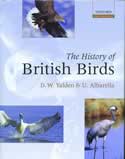
Publisher: Oxford University Press, Oxford
Publication Year: 2009
Binding: 2
Page Count: 263
ISBN Number: 978-0-19-921751-9
Price: £55.00
The History of British Birds
The foundation of this book is a database compiled by the authors of about 9000 records of birds in the 'archaeological' (not strictly this as not all the sites considered contain human remains) record from the middle Pleistocene to the present. There are six main chapterscovering records from early prehistory to Victorian times followed by a useful summary of the 20th Century as it relates to the past. There is also an appendix summarising the records of each species where records exist.
This database is far and away the most comprehensive set of records to date and hence the summaries here are by far the most useful and complete. There are some problems, and fully acknowledged by the authors, not least the identification of the specimens particularly to species level. But the overall picture presented gives us much greater accuracy both of the birds present and the environment they were in than I have seen anywhere previously. For example a detailed look at sites from Roman times shows the avifauna to be not unlike today and also that they ate a wide variety of species. Even then the most common bird in Britain was the Domestic Fowl and they certainly ate some Pheasants and there are even a few records of Peacock. The book also firmly squashes the idea that the Mute Swan is not a native -- it is found in late Glacial and Mesolithic sites. Other species appear quite often in mediaeval sites -- Cranes, White-tailed Eagles and Capercaillie were all clearly quite widespread; and Raven is especially a feature of Iron Age sites. A fascinating book and rather different from the usual range.
Book reviewed by Peter Lack





Share this page